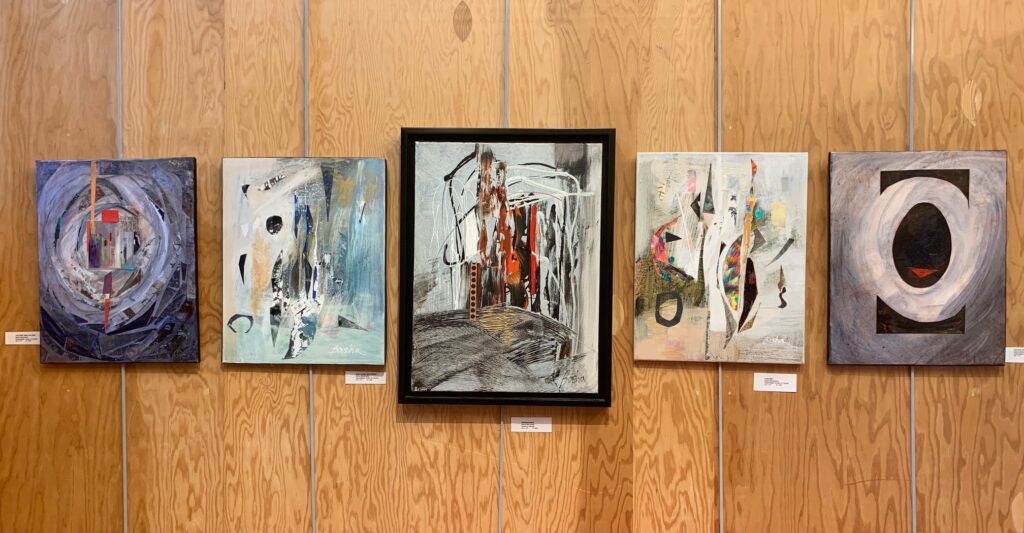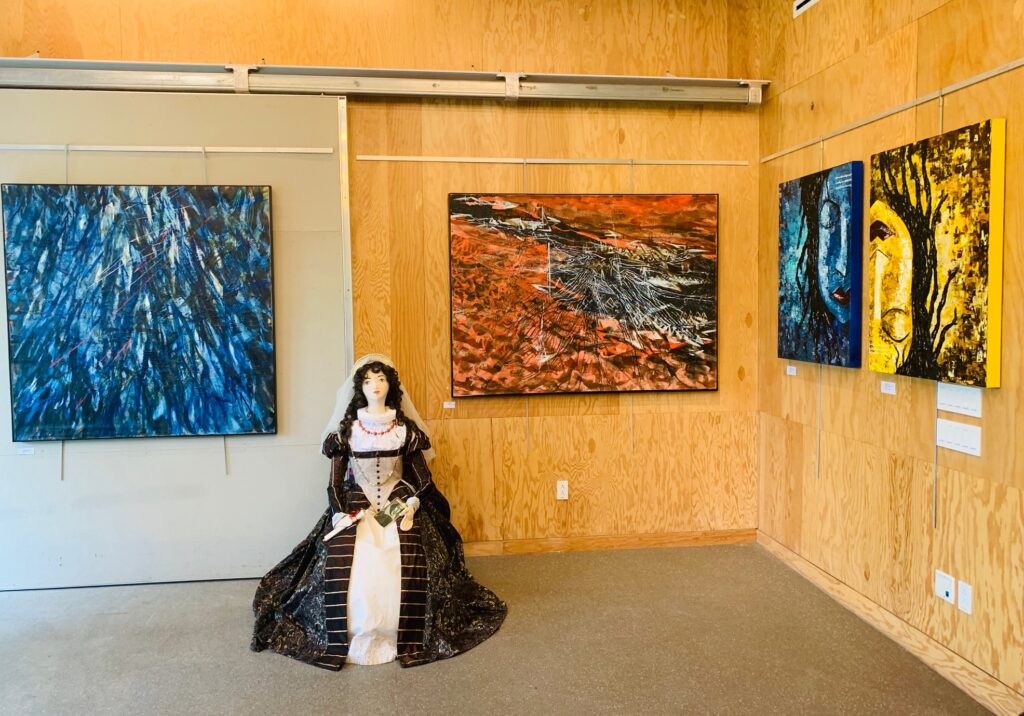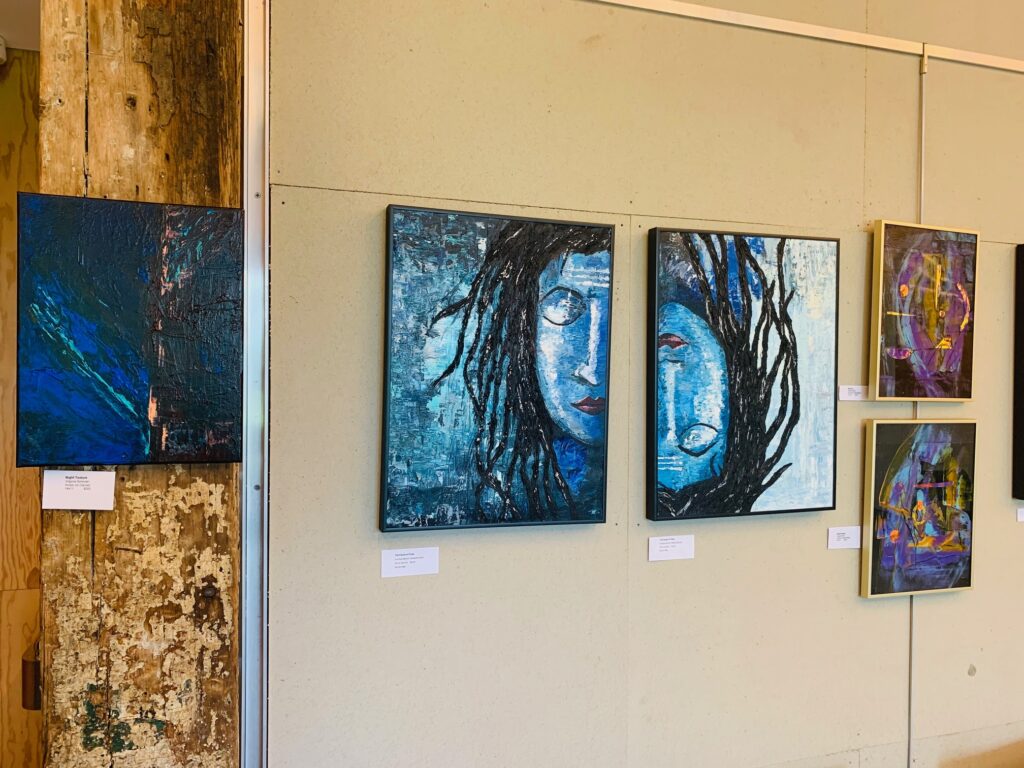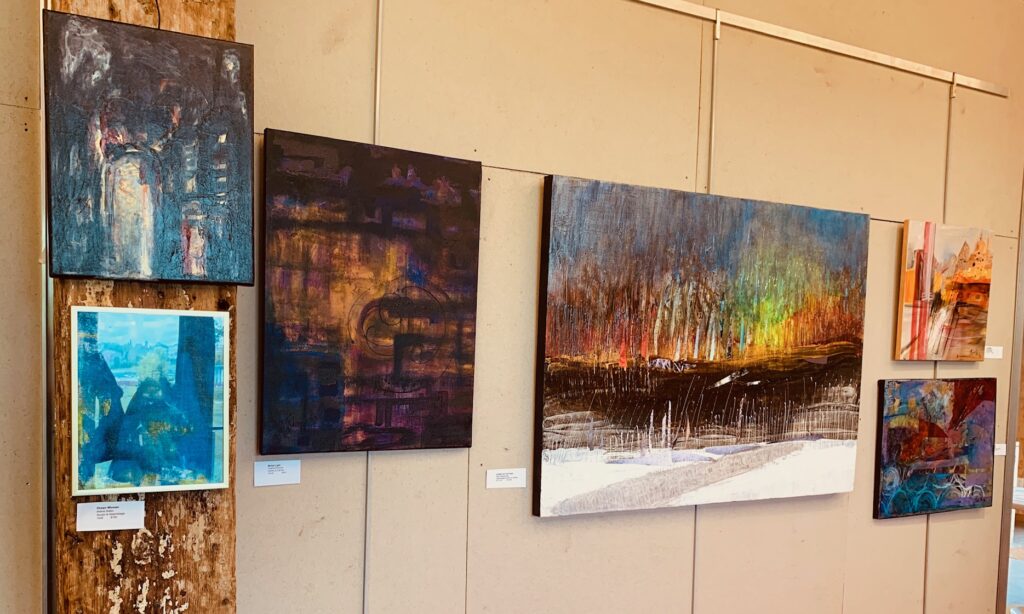Just recently, I had the happy opportunity to visit the “Seventh International Artists Residency,” held in May at The Scenic Hudson River Center, Beacon, N.Y. and curated by Basha Maryanska, where I enjoyed the beautiful work of 13 talented artists.

Eva Lachur shares with us her magnificent Shakespearean costumes along with beautifully realized tempera paintings. We see a young Jessica from “The Merchant of Venice,” clothed in dark fabric with touches of lights—signifying hope this young woman will be liberated from her father’s overbearing protection. Along with the ethereal realization of a blue wedding dress, worn by tragic Juliet, the doomed heroine clothed in azure underscores her separation from her family whose vestments were tinted red. Ms. Lachur demonstrates her knowledge of the Renaissance as many of the costumes are studies in color contrasts, a popular device used in dress at the time. Also showing her talent as a painter, she creates accomplished varnished tempera pictures, strongly evident in her piece “Ghost of the Blue Bird,” showing mother earth holding a lifeless bird in a scenario of the planet engulfed in murky waters with a shoreline of burning reactors and factories distantly spewing smoke. Ms. Lachur confides this is the first of a series of works about environmental issues and she hopes, through plastic arts that educate, to urgently communicate the terrible possibility of a dire future.

Mietko Rudek continues his love affair with cities on the move in his photos of places such as Paris, Warsaw, New York and Chicago. He romanticizes the urban space in pictures of the machines of frenetically moving cars in a glowing late night Times Square, a section of Queens at dusk, an impressionistic blur of Chicago, a lovely Paris street and a scene of Warsaw in atmospheric light, among other delights. He also wears the graphic designer’s hat for his fellow exhibiting artists, as he generously supplied publicity materials for this show.
Ilona Wojciechowska’s two moving wall hangings, seen at the residency, were also shown at the Polish Institute of Art and Science commemorating the 100th anniversary of Poland’s regaining independence from Russia in the Polish-Russian War. Here, in both these serious and intricate pieces, the newspaper clippings about the war, collaged in the pieces, underscore this time of militaristic might, with words cloaked in the blood red colors of the Polish flag.
Kamila Wojciechowicz-Krauze presents pleasing shadow boxes of mythological figures and allusions to art historical paintings, in pieces such as one showing a winged Pegasus, an Infanta Margerita from Las Meninas, and a Toro that could be a homage to Picasso’s interpretations of bullfights.
After taking classes with Basha Maryanska, Arlene Robin has found unique ways to express herself in acrylic collages, wherein she experiences a new sense of autonomy to create— with remarkable emotion coming forth. Ms. Robin is an art therapist and substance abuse counselor who is also able to work her own feelings through in colors. Here, she balances gold bits against complimentary violet passages in satisfying compositions. Her self-portrait is rendered with over-painted gestural black and orange lines, providing intriguing intimations of an energetic and sensitive persona.
In viewing the exhibit, I am struck by the breadth of Basha Maryanska’s creative abilities shown in her paintings and in Korean Joomchi paper art. In “Journey I and II,” she provides a sinuous rendering of curving line and paint, celebrating the Hudson River in all its sparkling majesty. Resulting from the painter’s gaze at scenery from the window of a Metro North train, glimmering impasto chromatic applications provide ecstatic impressions of mountains rising above a sunlit river. Of particular interest is Ms. Maryanska’s personal interpretations of the ancient Korean paper art where she layers materials in hanging pieces she calls Szmatas—cascades of color in flowing riotous reds, shimmering metallics, deep darks and delightful greens. Three new pieces of note are her meditative interpretations of the lotus and her profound piece “Requiem,” based upon Salieri’s mask from the play “Amadeus,” wherein the artist transforms the allusion to a death mask into a luminous vision. Reproductions of this painting will be part of a special exhibit, at a museum on Long Island, with images of the piece circulating throughout the world as works on postcards.
Katia Gerasimov paints a striking abstraction entitled “Dawn,” an oil on canvas where a yellow-orange boomeranglike object bursts forth from darks in a beacon of light piercing the night. This dynamic form cuts through the shadowy colors surrounding it and is emblematic of the happiness Ms. Gerasimov feels from the act of painting. It is a unique canvas.

Virginia Donovan continues her painterly journey in a broad range of pieces done during her time at the residency. The artist identifies feelings arising from the painting process that can be seen in her abstract works such as “Sound and Silence,” with the grey hushed and with strong geometrics unifying the color areas, and “Imminent Storm,” where cloud-like purple and silver painted energies roll menacingly over a ground of dark land. She masterfully uses silver in her works and most palpably in the painting, “Wind and Waves,” with the pigment strokes crashing as water throughout the piece. Ms. Donovan approaches her art daringly and completed a canvas here in Beacon that she brought partially painted, thereby creating a bold work by adhering horizontal blue paper strips to the canvas surface, indicating built structures—its entirety a robust statement she calls, “City Pulse.”
A strong abstractionist in the group is Piotr Czerwinski who grew up in Poland, surrounded by the beauties of nature, and was trained as a graphic artist and illustrator. His knowledge of craft and love of the natural world appear foremost in his paintings of flowing energy where he applies both oil and wax to the canvases. One work, entitled, “The Bay,” has white lines laid down as sweeping turbulence roiling the canvas, and impasto dashes cutting into dark seaweeded areas, painted on the diagonal, to create dynamic push/ pull tensions.
Srividya Ramachandran, new to the residency, brings a contemplative sensibility to the group. Her oil on canvas semi-abstract self-portraits are rendered through the application of paint and wax via palette knife, resulting in faces of vertical duality on the picture plane. Ms. Ramachandran tells me the forms facing down represent the more grounded female energies and those turned upward signify the male. For the artist, the faces are symbols of every man and woman with yellow pigment, used in the paintings to represent light, balancing darkness that the artist envisions from her own meditations, where she experiences a sense of timelessness.
We are fortunate to have Kathryn Hart’s mysterious ink drawings as part of the exhibit. Alluding to stripped-down bones, collected by the artist in the western United States, the pieces remind me of the remnants of animals, the flesh brutally torn from the carcasses by the scavengers of the desert. With black ink applied in almost automatic lines they morph into gestured markings of deep emotion. This is most dramatically seen in one of the drawings aptly entitled, “Insatiable Appetite.”
Katia Bulbenko, also new to the group, brings her very unusual multimedia collages of wood, painted silk, fabric and canvas that she manipulates digitally to create ambiguities of space in abstract assemblages. She interprets her love of geological formations in foam core representing blue aquifers that she likens to layers of change in her life. Influenced by the work of Frank Stella, but on a small scale, the artist integrates wabi-sabi imperfections as happy accidents in the process of making the pieces, so the results show a pleasing use of juxtapositions to realize unexpected stirring arrangements.
This time, Neela Pushparaj employs sumie brushwork to lovely effect in her watercolor, “Bamboo and Blossoms,” where the delicate strokes provide pleasing contrasts to the areas of broad diaphanous floral passages. Her painting, “Just Flowers,” which is a very textural water painting on canvas, looks as if the artist applied a pristine Chinese White to the surface, but it is really the bare canvas that she has masterfully used to her advantage by allowing it to shine through. Exuberantly, she paints bold blooms in “A Time to Sing,” where the use of pigment is more impressionistic and a departure from past work, now celebrating a new and effusive individuality.

In this seventh residency, Basha Maryanska has once again ingeniously gathered a group of singularly creative people under her auspices in one space in Beacon, NY. Now, she brings artists from all over the world to this community and throughout the duration of the time of the event, people with tools making marvelous art can be heard and seen throughout the venue. Providing a space where artists can share information and ideas, she emphasizes the importance of the residency and says it has really grown over the years so that now it takes place in other parts of the United States and also Europe. She enthuses that wherever it is held, people eagerly anticipate viewing the results. From Basha Maryanska’s love of art and artists, I know future residencies will come to fine fruition and I look forward to seeing the wonderful results in the many years ahead.
Recently seen at 7th International Artists Residency
8 Long Dock Road
Beacon
New York





Leave a Comment